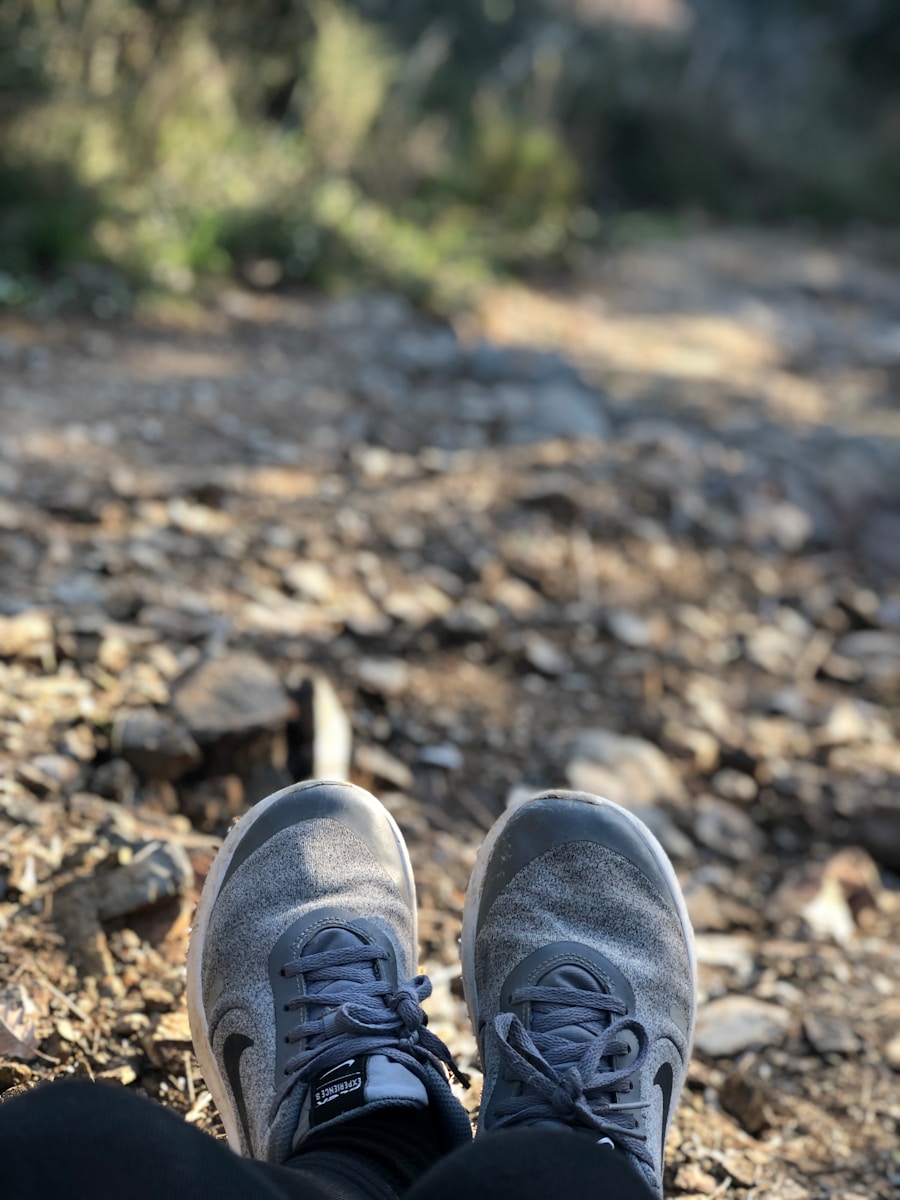Hiking shoes are specifically designed footwear that caters to the unique demands of outdoor trekking. Unlike regular athletic shoes, hiking shoes are built to provide stability, support, and protection on uneven terrain. They often feature rugged outsoles for enhanced traction, reinforced toe caps to shield against rocks and roots, and water-resistant materials to keep feet dry in wet conditions.
The design of hiking shoes varies significantly based on the type of hiking they are intended for, ranging from lightweight trail runners to heavy-duty mountaineering boots. This diversity allows hikers to select footwear that best suits their specific needs, whether they are embarking on a leisurely day hike or tackling a challenging multi-day trek. The evolution of hiking shoes has been influenced by advancements in technology and materials.
Modern hiking shoes often incorporate breathable mesh fabrics, cushioned midsoles, and advanced lacing systems that enhance fit and comfort. These innovations not only improve performance but also contribute to the overall enjoyment of the hiking experience. As outdoor activities gain popularity, understanding the nuances of hiking footwear becomes increasingly important for enthusiasts looking to optimize their adventures.
One question that frequently arises among outdoor enthusiasts is whether hiking shoes can also serve as suitable footwear for running.
Key Takeaways
- Hiking shoes are designed for outdoor activities such as hiking, trekking, and mountaineering, providing stability, support, and protection for the feet and ankles.
- Running shoes are designed for forward motion and impact absorption, while hiking shoes are designed for stability, traction, and protection on uneven terrain.
- Running in hiking shoes can lead to discomfort, blisters, and potential injury due to the heavier weight and stiffer construction of hiking shoes.
- Running in hiking shoes can provide better traction, durability, and ankle support for trail running and off-road running activities.
- To run in hiking shoes, it is important to choose a lightweight and flexible pair, break them in gradually, and consider the specific terrain and distance of the running route.
Differences Between Running Shoes and Hiking Shoes
Design Features of Running Shoes
Running shoes prioritize lightweight construction and cushioning to facilitate forward motion on smooth surfaces. They typically feature a flexible sole that allows for a natural foot movement during the running gait cycle. The cushioning in running shoes is often concentrated in the heel and forefoot areas to absorb impact during repetitive strides on pavement or track surfaces. Additionally, running shoes tend to have a lower profile, which promotes speed and agility.
Design Features of Hiking Shoes
In contrast, hiking shoes are engineered for stability and support on uneven and unpredictable terrain. The outsoles of hiking shoes are generally more aggressive, featuring deeper lugs that provide superior grip on rocky or slippery surfaces. The midsoles are often stiffer than those found in running shoes, offering enhanced support for the foot and ankle during lateral movements and uneven ground.
Key Differences and Importance of Selection
Furthermore, hiking shoes may include features such as waterproof membranes and reinforced toe caps, which are not typically found in running footwear. These design elements reflect the different demands placed on each type of shoe, highlighting the importance of selecting the right footwear based on the intended activity.
Impact of Running in Hiking Shoes

Running in hiking shoes can have a significant impact on performance and comfort, particularly when transitioning from traditional running footwear. The stiffer construction of hiking shoes can alter a runner’s gait, potentially leading to changes in stride length and foot placement. This shift may result in increased fatigue over longer distances, as the muscles used for stabilization work harder than they would in a more flexible running shoe.
Additionally, the added weight of hiking shoes compared to running shoes can affect speed and overall efficiency during runs. Moreover, the traction provided by hiking shoes can be both an advantage and a disadvantage when running on various surfaces. On rugged trails or uneven terrain, the aggressive lugs of hiking shoes can enhance grip and stability, allowing runners to navigate obstacles with confidence.
However, on smoother surfaces such as pavement or packed dirt trails, the same lugs may create additional drag, making it more challenging to maintain speed. Runners may also experience discomfort if they are not accustomed to the stiffer sole of hiking shoes, particularly during longer runs where foot fatigue becomes a factor.
Benefits of Running in Hiking Shoes
| Benefits of Running in Hiking Shoes |
|---|
| 1. Durability |
| 2. Traction |
| 3. Stability |
| 4. Protection |
| 5. Comfort |
Despite some drawbacks, there are several benefits to running in hiking shoes that make them an appealing option for certain individuals. One of the primary advantages is the increased support and stability they provide. For runners who frequently tackle technical trails or uneven surfaces, the added ankle support from hiking shoes can help prevent injuries such as sprains or strains.
This is particularly beneficial for those who may have a history of ankle instability or who are prone to rolling their ankles while navigating rocky paths. Another significant benefit is the durability of hiking shoes. Constructed with robust materials designed to withstand harsh outdoor conditions, these shoes can endure wear and tear better than standard running shoes.
For runners who frequently find themselves in rugged environments or who engage in activities that require traversing through mud, water, or rocky terrain, the longevity of hiking shoes can be a considerable advantage. Additionally, many hiking shoes offer water-resistant features that keep feet dry during wet conditions, enhancing comfort during runs in inclement weather.
Drawbacks of Running in Hiking Shoes
While there are benefits to running in hiking shoes, there are also notable drawbacks that should be considered. One significant issue is weight; hiking shoes tend to be heavier than traditional running shoes due to their sturdier construction and additional protective features. This extra weight can lead to increased fatigue over longer distances and may hinder performance for those who prioritize speed during their runs.
Another drawback is the stiffness of hiking shoes, which can limit flexibility and responsiveness compared to running-specific footwear. Runners accustomed to the soft cushioning and flexibility of running shoes may find that hiking shoes do not provide the same level of comfort during longer runs. The rigid midsoles can lead to discomfort or pain in the feet and legs if not properly broken in or if used for extended periods without acclimatization.
Additionally, the fit of hiking shoes may differ from that of running shoes; some runners may find that they do not achieve the same snug fit necessary for optimal performance.
Tips for Running in Hiking Shoes

For those who choose to run in hiking shoes, there are several tips that can enhance comfort and performance while minimizing potential drawbacks. First and foremost, it is essential to select a pair of hiking shoes that fit well and provide adequate support for your foot type. Trying on different brands and styles can help identify which shoe offers the best fit for your unique foot shape and size.
Breaking in your hiking shoes before embarking on longer runs is crucial. Gradually increasing your mileage while wearing them will allow your feet to adjust to the stiffer sole and different fit characteristics. Start with shorter runs on familiar terrain before progressing to more challenging trails or longer distances.
Additionally, consider incorporating strength training exercises into your routine to build up the muscles used for stabilization when running on uneven surfaces. Another important tip is to pay attention to your running form while wearing hiking shoes. The added weight and stiffness may require adjustments in your stride or foot placement to maintain efficiency and comfort.
Focus on maintaining a relaxed posture and landing softly on your feet to reduce impact stress. Lastly, be mindful of the terrain you choose for your runs; while hiking shoes excel on rugged trails, they may not perform as well on smooth surfaces where traditional running shoes would be more appropriate.
Choosing the Right Hiking Shoes for Running
Selecting the right pair of hiking shoes for running involves considering several factors that align with your specific needs and preferences. First, assess the type of terrain you plan to run on most frequently. If you primarily run on technical trails with rocks and roots, look for hiking shoes with aggressive outsoles that provide excellent traction and stability.
Conversely, if your runs will take place on smoother paths or less rugged terrain, consider lighter-weight options with less aggressive tread patterns. Fit is another critical aspect when choosing hiking shoes for running. Ensure that there is enough room in the toe box to accommodate foot swelling during runs while still providing a snug fit around the heel and midfoot.
Many brands offer different widths or customizable lacing systems that can help achieve a better fit. Additionally, consider features such as waterproofing or breathability based on your local climate and typical weather conditions during your runs. Finally, take into account your personal preferences regarding cushioning and support levels.
Some runners prefer minimal cushioning for a more natural feel, while others may require additional padding for comfort over longer distances. Trying on multiple pairs and taking them for short test runs can help determine which shoe best meets your needs.
Can You Run in Hiking Shoes?
The question of whether you can run in hiking shoes does not have a straightforward answer; it largely depends on individual preferences, running style, and the specific conditions under which one intends to run. While hiking shoes offer certain advantages such as stability, durability, and protection from rough terrain, they also come with drawbacks like increased weight and stiffness that may not suit every runner’s needs. Ultimately, those who choose to run in hiking shoes should carefully consider their unique circumstances—such as terrain type, distance goals, and personal comfort—before making a decision.
With proper selection and acclimatization, many runners find that they can successfully incorporate hiking shoes into their routine without sacrificing performance or comfort. Whether you are an avid trail runner or someone who enjoys occasional hikes mixed with running sessions, understanding the nuances between these two types of footwear will empower you to make informed choices that enhance your outdoor experiences.
If you’re looking for a versatile travel accessory, consider investing in a portable WiFi hotspot for international travel. This device will ensure that you stay connected wherever you go, allowing you to easily research hiking trails, book accommodations, and stay in touch with loved ones back home. Check out our article on the best portable WiFi hotspots for international travel here.
FAQs
What are hiking shoes?
Hiking shoes are a type of footwear designed for outdoor activities such as hiking, trekking, and walking on uneven terrain. They are typically lightweight, durable, and provide good traction and support for the feet.
Can I run in hiking shoes?
While hiking shoes are designed for walking and hiking on rugged terrain, they may not be the best choice for running. Hiking shoes are typically stiffer and provide more ankle support, which may not be ideal for the repetitive motion of running. It is recommended to use running shoes for running activities.
What are the differences between hiking shoes and running shoes?
Hiking shoes are designed with a focus on stability, support, and traction for walking on uneven surfaces, while running shoes are designed to provide cushioning, flexibility, and responsiveness for the repetitive motion of running. Hiking shoes often have a more rugged outsole and a stiffer midsole compared to running shoes.
Can I use hiking shoes for trail running?
While some people may choose to use hiking shoes for trail running, it is generally not recommended. Trail running shoes are specifically designed to provide the necessary cushioning, flexibility, and traction for running on trails, whereas hiking shoes may not offer the same level of comfort and performance for running activities.
What should I consider when choosing footwear for running or hiking?
When choosing footwear for running or hiking, it is important to consider factors such as the terrain, distance, and personal comfort preferences. Running shoes are designed for the repetitive motion of running and provide cushioning and flexibility, while hiking shoes are designed for stability and support on rugged terrain. It is best to choose footwear specifically designed for the activity you plan to engage in.
